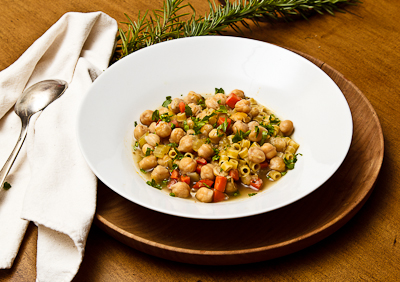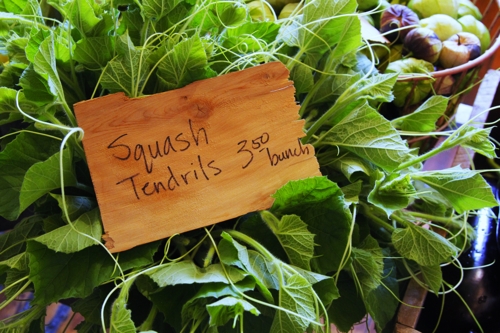Was it only two years ago that we first presented our recipe for Pasta e Ceci to celebrate Pope Francis’s ascension to the Papacy? The peripatetic Holy Father has covered a lot of ground since then and now he’s here, back in the New World.
 Pasta e Ceci
Pasta e Ceci
Copyright © 2013, Skip Lombardi
To welcome him, we once again offer this modest, everyday Roman dish, a heavenly combination of ditalini and chick-peas. We can well imagine that after a week of airline food and banquets, the Holy Father may be yearning for a little home-cooking.
For Pasta e Ceci, Romans favor ditalini, which cook quickly within the broth of already-cooked pulses. Also called paternoster and avemarie, Our Father and Hail Mary, these short semolina tubes are reminiscent of rosary beads. Since devout cooks often said their evening prayers while preparing supper, some families maintained a tradition of gauging the cooking of their pasta according to the time it took to recite one or more prayers!
 Ditalini
Ditalini with traditional kitchen timer
Copyright © 2013, Skip Lombardi
The dish is quickly assembled. Just be sure your chickpeas are thoroughly cooked before you begin.
Ingredients:
For the battuto:
Olive oil
1 large stalk of celery, cut into 1/2-inch dice (reserve any leaves for garnish)
1 medium onion (about 4 ounces), cut into 1/4-inch dice
1 large carrot, peeled and cut into 1/4-inch dice
4 Tablespoons flat-leaf Italian parsley including stems, finely chopped
2 Cloves garlic, peeled and finely chopped
1 bay leaf
For the soup:
1/2 teaspoon dry marjoram
1 teaspoon freshly ground black pepper
8 ounces dry chickpeas, soaked and cooked according to package directions, OR
2 15-ounce cans of cooked chickpeas, drained & rinsed
8 ounces ditalini
4 Tablespoons flat-leaf Italian parsley, finely chopped.
To garnish:
Extra virgin olive oil to drizzle
Additional chopped parsley & any celery leaves
Freshly grated Parmesan cheese (optional)
Make your battuto
Heat a 4 to 6-quart pot over medium-high heat, then add enough olive oil to coat the bottom of the pot.
Lower the heat to medium-low and add all the ingredients for the batutto. Sauté, stirring occasionally for approximately 10 minutes, or until the ingredients soften and barely begin to caramelize.
Make the soup:
Add the marjoram and a few grinds of black pepper and stir. Cook for a minute or two, allowing the herbs and pepper to begin to permeate the batutto.
Add the drained canned chickpeas (OR the home-cooked chickpeas and their cooking liquid) to the battuto. Add additional water so that you have a total of 6 cups of liquid in the pot. Adjust the heat and simmer for approximately 10 minutes.
Have your garnishes ready as the pasta will cook very quickly.
Add the ditalini to the broth and simmer, uncovered, for about 2 minutes before you test one of the ditalini.If the pasta has reached the al dente state, the soup is ready. If not, continue cooking and tasting for another 1-2 minutes.
To Serve:
Ladle the soup into shallow bowls. Drizzle a teaspoon of fruity olive oil over each portion and garnish with parsley and freshly grated Parmesan cheese.
Benvenuto, Francesco e buon appetito a tutti!
Serves 4-6.




